 My colleague Sam Millette, senior investment research analyst on Commonwealth’s Investment Management and Research team, has helped me put together this month’s Economic Risk Factor Update. Thanks for the assist, Sam!
My colleague Sam Millette, senior investment research analyst on Commonwealth’s Investment Management and Research team, has helped me put together this month’s Economic Risk Factor Update. Thanks for the assist, Sam!
The economic recovery continued to accelerate in June, driven by improvements on the public health front and ongoing reopening efforts that left almost all of the country open by the end of the month. The June employment report showed that the pace of hiring picked up, as headline job growth came in above economist estimates. Consumer confidence rose notably in June and now sits near pre-pandemic levels. Business confidence saw a slight pullback but remains above pre-pandemic levels, signaling continued growth ahead.
Despite the very real progress during the month, not all the news was good. On the medical side, case growth stopped declining at the end of the month, suggesting further improvements might be at risk. On the economic side, supply chain issues remain an unresolved question, and employment is well below pre-pandemic levels. Overall, we’ve kept the economic risk level at yellow for now, but an upgrade to green remains possible in the upcoming months if those problems resolve. Although we have made progress in terms of containing the pandemic and bringing the economy back, we are not there yet, and the uncertain path to normal indicates that economic risks remain.
The Service Sector
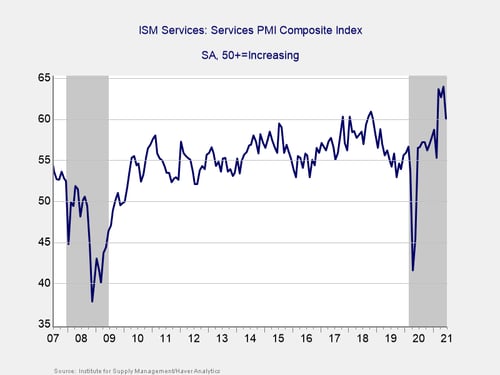
Signal: Green light
Service sector confidence declined by more than expected in June, with the index falling from 64 in May to 60.1 in June against forecasts for a more modest decline to 63.5. This pullback from May’s record level still represents healthy service sector confidence, well above what we have seen throughout almost all of the past decade. This is a diffusion index, where values above 50 indicate expansion, so the report showed that the service sector continued to grow at a strong pace.
Service sector confidence has rebounded well since suffering from a largely weather-driven decline in February, and the index has now remained above pre-pandemic levels for four straight months. Service sector confidence has been supported by public health improvements and the associated easing of state and local restrictions that have given business owners more confidence in the ongoing economic recovery. High levels of service sector confidence are a good sign for business investment and hiring, as improved confidence has historically supported faster spending growth.
Given the fact that service sector confidence has remained above pre-pandemic levels for the past four months, we have left this signal at a green light for now, despite the index’s decline in June.
Private Employment: Annual Change
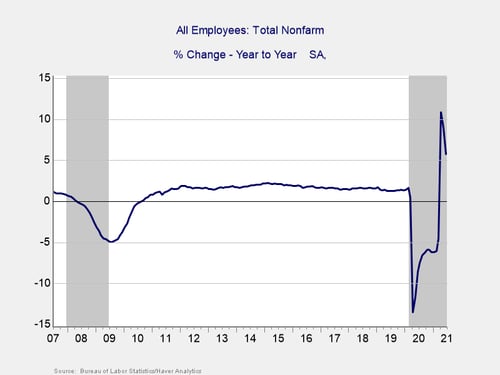
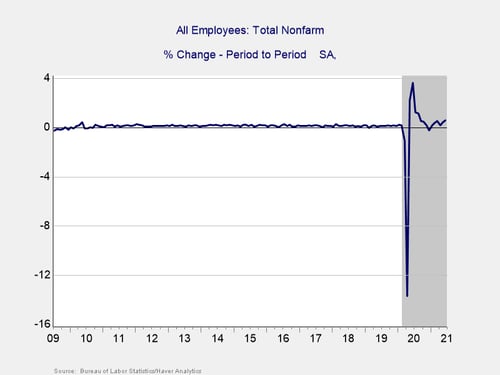
Signal: Yellow light
June’s employment report showed that the economy added 850,000 jobs during the month, an increase from the upwardly revised 583,000 jobs that were added in May and above economist estimates for 720,000 additional jobs. This result now marks six straight months with job growth following a temporary lull in hiring last December. The hard-hit leisure and hospitality sector saw some of the largest gains during the month due to the continued easing of state and local restrictions that allowed more businesses to reopen.
Although June saw year-over-year employment increase by 5.8 percent, this was primarily due to the large decline in jobs that we saw last spring and summer when initial lockdowns were implemented. The total number of jobs across the economy remains down by more than 6.7 million compared with pre-pandemic peak levels.
While the continued job growth during the month was a positive development, it would take eight months of hiring at a similar rate to get back to pre-pandemic employment levels. Given the still large decline in overall employment compared with the pre-pandemic peak, we have left this indicator at a yellow light for now, with an upgrade to green possible in the months ahead if we continue to see accelerated job growth.
Yield Curve (10-Year Minus 3-Month Treasury Rates)
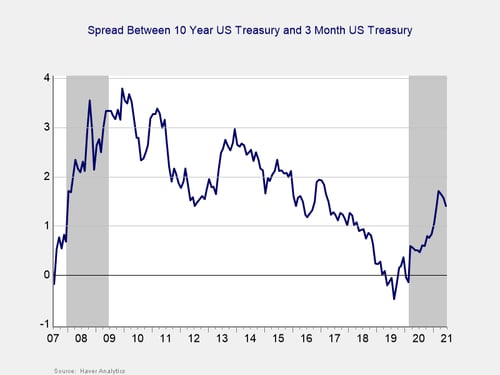
Signal: Green light
The yield curve flattened during the month, marking three consecutive months of yield curve flattening. This result was primarily driven by a decline in long-term interest rates. The 10-year Treasury yield fell from 1.58 percent at the end of May to 1.45 percent at the end of June. The decline in long-term yields was largely driven by investor concerns about the rising risk from the Delta variant of the virus. The 3-month Treasury yield increased from 0.01 percent at the end of May to 0.05 percent at the end of June. While short-term rates are expected to remain low until at least 2023, longer-term rates had previously recovered back to pre-pandemic levels before the recent decline. Although long-term rates remain well above the pandemic-induced lows we saw throughout much of last year, the recent decline is worth monitoring, as it could signal investor concern about the pace of the economic recovery.
Given the fact that long-term yields remain above the 2020 lows, we have kept this signal at green light for now. But if long-term rates continue to decline, we may see further yield curve flattening and a potential downgrade to yellow.
Consumer Confidence: Annual Change
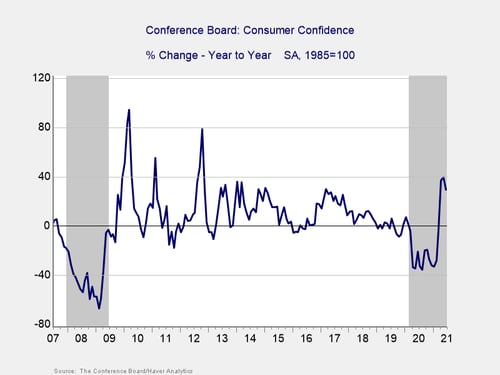
Signal: Green light
Consumer confidence increased by more than expected in June. The Conference Board Consumer Confidence Index rose from an upwardly revised 120 in May to 127.3 in June against calls for a modest decline to 119. This better-than-expected result brought the index to its highest level in 16 months and signals that consumer sentiment improved notably. Confidence has been supported by improvements in public health, additional rounds of federal stimulus payments, and accelerating job growth.
While the 29.5 percent year-over-year increase in confidence was largely due to a sharp drop in confidence last June, the recent improvements for the index have brought confidence back to pre-pandemic levels. Historically, declines in confidence of 20 percent or more over the past year are a signal of a recession, so the recent improvement in the year-over-year data in the past four months has been very encouraging, as it has brought the year-over-year figure out of the historical danger zone.
Given the fact that confidence has now returned to pre-pandemic levels and remains strong on a year-over-year basis, we have left this indicator at a green light for now. Looking forward, continued job growth and progress on the mass vaccination front should help to support high levels of consumer confidence and spending growth as we head into the summer months.
Conclusion: Economic Growth Ahead
The economic data releases from June largely pointed toward accelerated growth in the months ahead. The improvements for consumer confidence and job growth were encouraging signs that the economic recovery continued to pick up steam in June, driven by improvements on the public health front and the nationwide reopening efforts.
While continued growth remains the most likely path forward, it’s too early to say that we are back to normal. The high levels of business and consumer confidence should continue to support additional spending growth; however, risks remain, which could cause uncertainty over the path and pace of the expected recovery. We’ve seen uncertainty rise in July, as markets have experienced some volatility driven by growing concerns about the Delta variant.
Given this uncertainty and the continued stress on the labor market, risks to the economic recovery remain, even if continued growth is the most likely path forward. The continued recovery in June was encouraging, and we have left three of the four indicators at a green light for now, with a future upgrade to the labor market possible if we continue to see accelerated job growth. We have left the overall economic risk indicator at a yellow light for now, with the prospect for an upgrade in the upcoming months if we see further improvements.



 Print
Print

